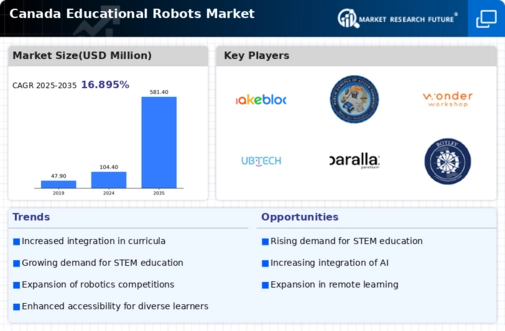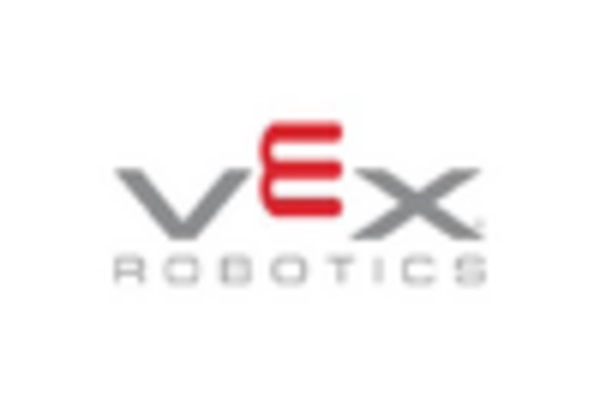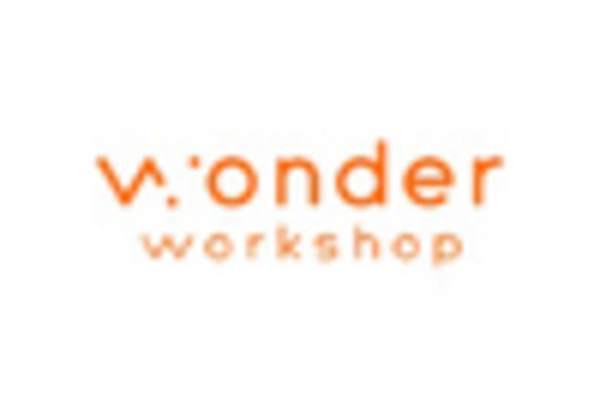Support for Special Education
The educational robots market is increasingly recognized for its potential to support special education needs in Canada. Educational robots can provide tailored learning experiences for students with diverse abilities, fostering inclusivity in the classroom. In recent years, the market has seen a rise in the development of robots specifically designed to assist students with autism and other learning disabilities. This trend is supported by research indicating that 70% of educators believe that robotics can enhance learning outcomes for students with special needs. As schools strive to create inclusive environments, the educational robots market is likely to expand, driven by the demand for adaptive technologies that cater to individual learning requirements.
Collaboration with Industry Partners
The educational robots market is increasingly characterized by collaboration between educational institutions and industry partners. This synergy aims to bridge the gap between theoretical knowledge and practical application, providing students with real-world experiences. In Canada, partnerships between schools and technology companies are becoming more common, with initiatives that promote the use of educational robots in classrooms. Such collaborations not only enhance the learning experience but also prepare students for future careers in technology and engineering fields. The educational robots market is likely to thrive as these partnerships expand, leading to the development of innovative educational tools and resources that align with industry standards and expectations.
Increased Investment in STEM Education
The educational robots market in Canada is experiencing a surge in investment aimed at enhancing STEM (Science, Technology, Engineering, and Mathematics) education. Government initiatives and private sector funding are increasingly directed towards integrating robotics into educational curricula. In 2025, it is estimated that investments in educational technology, including robotics, could reach approximately $1 billion, reflecting a growing recognition of the importance of equipping students with essential skills for the future workforce. This trend is likely to drive demand for educational robots, as schools and educational institutions seek innovative tools to engage students and foster critical thinking. The educational robots market is thus positioned to benefit from this influx of resources, which may lead to the development of more advanced and accessible robotic solutions for learners across various age groups.
Advancements in Artificial Intelligence
The educational robots market is poised for growth due to advancements in artificial intelligence (AI) technologies. AI integration into educational robots enhances their capabilities, allowing for more personalized and adaptive learning experiences. In Canada, the market is expected to see a rise in AI-driven educational robots that can assess student performance and adjust their teaching methods accordingly. This evolution in technology may lead to a more effective learning environment, where robots can provide real-time feedback and support. The educational robots market stands to benefit from these innovations, as schools and educational institutions seek to leverage AI to improve educational outcomes and foster a deeper understanding of complex subjects.
Growing Demand for Interactive Learning Tools
The educational robots market is witnessing a notable increase in demand for interactive learning tools that facilitate hands-on experiences for students. As educators recognize the effectiveness of experiential learning, the integration of robotics into classrooms is becoming more prevalent. In Canada, approximately 60% of teachers report using technology to enhance student engagement, with educational robots being a key component of this strategy. This shift towards interactive learning is likely to propel the educational robots market forward, as schools invest in robotic kits and platforms that allow students to build, program, and interact with robots. The emphasis on interactive learning not only enhances student motivation but also aligns with modern pedagogical approaches that prioritize active participation and collaboration.
















Leave a Comment